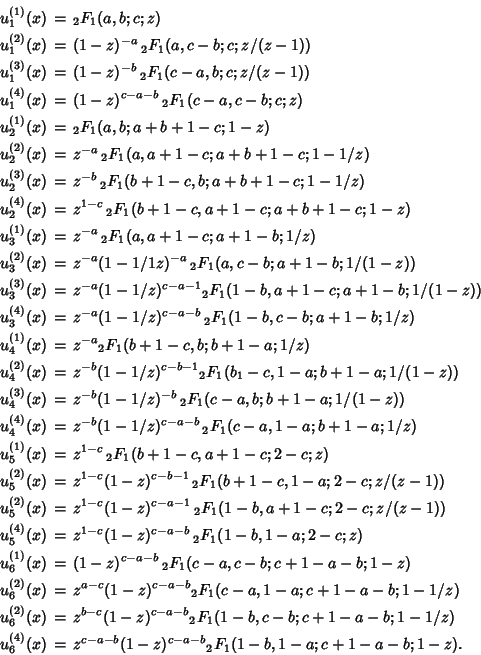|
|
|
A Generalized Hypergeometric Function
![]() is a function which can be defined
in the form of a Hypergeometric Series, i.e., a series for which the ratio of successive terms can be written
is a function which can be defined
in the form of a Hypergeometric Series, i.e., a series for which the ratio of successive terms can be written
| (1) |
The hypergeometric functions are solutions to the Hypergeometric Differential Equation, which has a Regular
Singular Point at the Origin. To derive the hypergeometric function based on the Hypergeometric Differential
Equation, plug
 |
(2) | ||
 |
(3) | ||
 |
(4) |
| (5) |
|
|
|
|
|
(6) |
|
|
|
|
|
(7) |
|
|
|
|
|
(8) |
![\begin{displaymath}
\sum_{n=0}^\infty [n(n+1)A_{n+1}-n(n-1)A_n+c(n+1)A_{n-1}-(a+b+1)nA_n-abA_n]z^n=0
\end{displaymath}](h_2303.gif) |
(9) |
![\begin{displaymath}
\sum_{n=0}^\infty \left\{{(n+1)(n+c)A_{n+1}-[n(n-1+a+b+1)+ab]A_n}\right\}z^n=0
\end{displaymath}](h_2304.gif) |
(10) |
![\begin{displaymath}
\sum_{n=0}^\infty \{(n+1)(n+c)A_{n+1}-[n^2+(a+b)n+ab]A_n\} z^n=0,
\end{displaymath}](h_2305.gif) |
(11) |
| (12) |
| (13) |
 |
|||
 |
(14) |
| (15) |
Derivatives are given by
 |
 |
(16) | |
 |
 |
(17) |
| (18) |
A hypergeometric function can be written using Euler's Hypergeometric Transformations
| (19) | |||
| (20) | |||
| (21) | |||
| (22) |
| (23) | |||
| (24) | |||
| (25) |
|
|
|
|
|
(26) |
Applying Euler's Hypergeometric Transformations to the Kummer solutions then gives all 24 possible forms which are solutions to the Hypergeometric Differential Equation

Goursat (1881) gives many hypergeometric transformation Formulas, including several cubic transformation Formulas.
Many functions of mathematical physics can be expressed as special cases of the hypergeometric functions. For example,
| (27) |
| (28) |
| (29) |
|
|
(30) |
|
|
(31) |
|
|
(32) |
![$\quad {}_2F_1(a,b;{\textstyle{1\over 2}}(a+b+1);{\textstyle{1\over 2}}) = {\Gam...
...b)]\over\Gamma[{\textstyle{1\over 2}}(1+a)]\Gamma[{\textstyle{1\over 2}}(1+b)]}$](h_2350.gif)
|
(33) |
![$\quad {}_2F_1(a,1-a;c;{\textstyle{1\over 2}}) = {\Gamma({\textstyle{1\over 2}}c...
...]\over\Gamma[{\textstyle{1\over 2}}(a+c)]\Gamma[{\textstyle{1\over 2}}(1+c-a)]}$](h_2351.gif)
|
(34) |
|
|
(35) |
| (36) |
Hypergeometric functions can be generalized to Generalized Hypergeometric Functions
| (37) |
See also Appell Hypergeometric Function,
References
Abramowitz, M. and Stegun, C. A. (Eds.). ``Hypergeometric Functions.'' Ch. 15 in
Handbook of Mathematical Functions with Formulas, Graphs, and Mathematical Tables, 9th printing.
New York: Dover, pp. 555-566, 1972.
Arfken, G. ``Hypergeometric Functions.'' §13.5 in Mathematical Methods for Physicists, 3rd ed.
Orlando, FL: Academic Press, pp. 748-752, 1985.
Fine, N. J. Basic Hypergeometric Series and Applications. Providence, RI: Amer. Math. Soc., 1988.
Gasper, G. and Rahman, M. Basic Hypergeometric Series. Cambridge, England: Cambridge University Press, 1990.
Gauss, C. F. ``Disquisitiones Generales Circa Seriem Infinitam
Gessel, I. and Stanton, D. ``Strange Evaluations of Hypergeometric Series.'' SIAM J. Math. Anal. 13, 295-308, 1982.
Gosper, R. W. ``Decision Procedures for Indefinite Hypergeometric Summation.'' Proc. Nat. Acad. Sci. USA 75, 40-42, 1978.
Goursat, M. E. ``Sur l'équation différentielle linéaire qui admet pour intégrale la série
hypergéométrique.'' Ann. Sci. École Norm. Super. Sup. 10, S3-S142, 1881.
Iyanaga, S. and Kawada, Y. (Eds.). ``Hypergeometric Functions and Spherical Functions.'' Appendix A, Table 18 in
Encyclopedic Dictionary of Mathematics. Cambridge, MA: MIT Press, pp. 1460-1468, 1980.
Kummer, E. E. ``Über die Hypergeometrische Reihe.'' J. für die Reine Angew. Mathematik 15, 39-83 and 127-172, 1837.
Magnus, W. and Oberhettinger, F. Formulas and Theorems for the Special Functions of Mathematical Physics.
New York: Chelsea, 1949.
Morse, P. M. and Feshbach, H. Methods of Theoretical Physics, Part I. New York: McGraw-Hill, pp. 541-547, 1953.
Petkovsek, M.; Wilf, H. S.; and Zeilberger, D. A=B. Wellesley, MA: A. K. Peters, 1996.
Press, W. H.; Flannery, B. P.; Teukolsky, S. A.; and Vetterling, W. T. ``Hypergeometric Functions.'' §6.12 in
Numerical Recipes in FORTRAN: The Art of Scientific Computing, 2nd ed. Cambridge, England:
Cambridge University Press, pp. 263-265, 1992.
Seaborn, J. B. Hypergeometric Functions and Their Applications. New York: Springer-Verlag, 1991.
Snow, C. Hypergeometric and Legendre Functions with Applications to Integral Equations of Potential Theory.
Washington, DC: U. S. Government Printing Office, 1952.
Spanier, J. and Oldham, K. B. ``The Gauss Function
![]() Hypergeometric Functions
Hypergeometric Functions
![]()
![]() etc. Pars Prior.'' Commentationes Societiones Regiae Scientiarum Gottingensis Recentiores, Vol. II. 1813.
etc. Pars Prior.'' Commentationes Societiones Regiae Scientiarum Gottingensis Recentiores, Vol. II. 1813.
![]() .''
Ch. 60 in An Atlas of Functions. Washington, DC: Hemisphere, pp. 599-607, 1987.
.''
Ch. 60 in An Atlas of Functions. Washington, DC: Hemisphere, pp. 599-607, 1987.
|
|
|
© 1996-9 Eric W. Weisstein